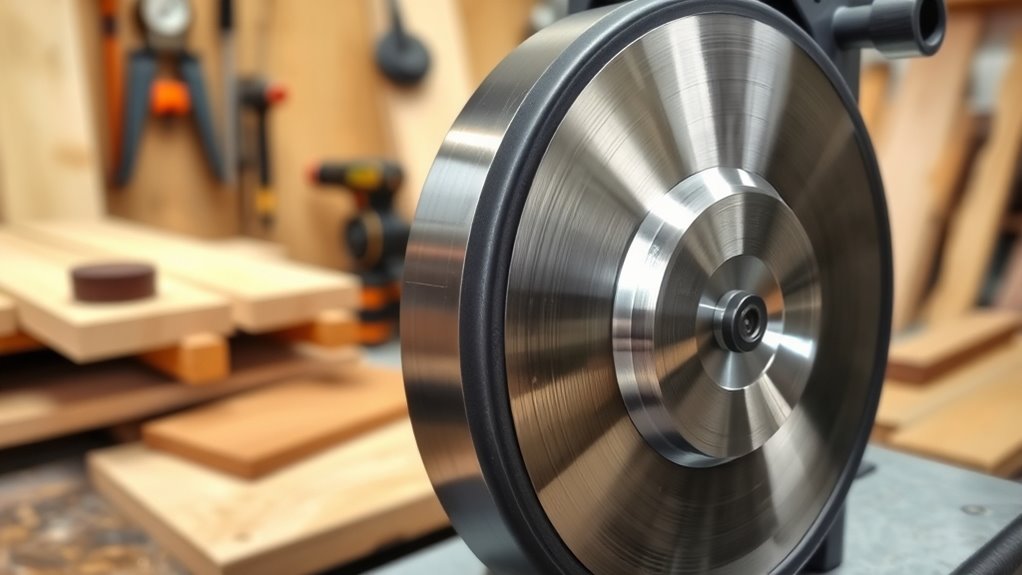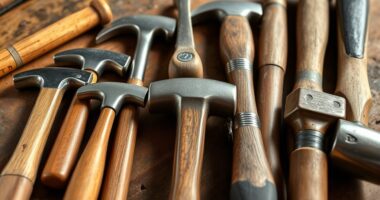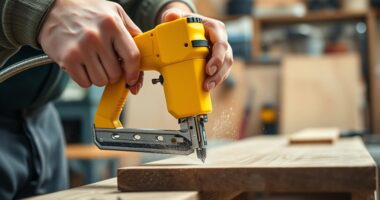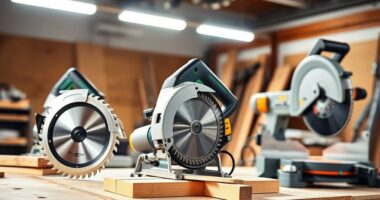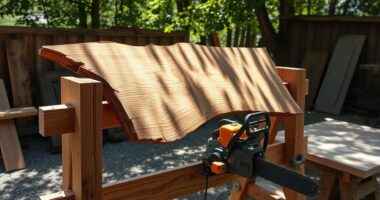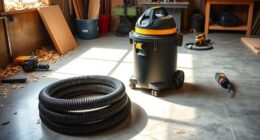To keep your bandsaw running smoothly, you need to focus on wheel alignment, tracking, and tension. First, verify the wheels are aligned by checking that the blade sits evenly and doesn’t wobble when it runs. Adjust the tracking to keep the blade centered on the wheels, preventing wandering during cuts. Finally, set the proper tension based on your blade size and type to avoid slipping or damage. Knowing these steps will improve your cuts and extend your saw’s life.
Key Takeaways
- Ensure wheels are properly aligned to prevent blade drift and ensure smooth operation.
- Adjust tracking to keep the blade centered on the wheels and prevent wandering during cuts.
- Set the correct blade tension according to manufacturer guidelines to avoid slipping or damage.
- Regularly check for wobbling or off-center tracking and make necessary adjustments.
- Follow safety procedures and unplug the saw before performing wheel alignment, tracking, or tension adjustments.
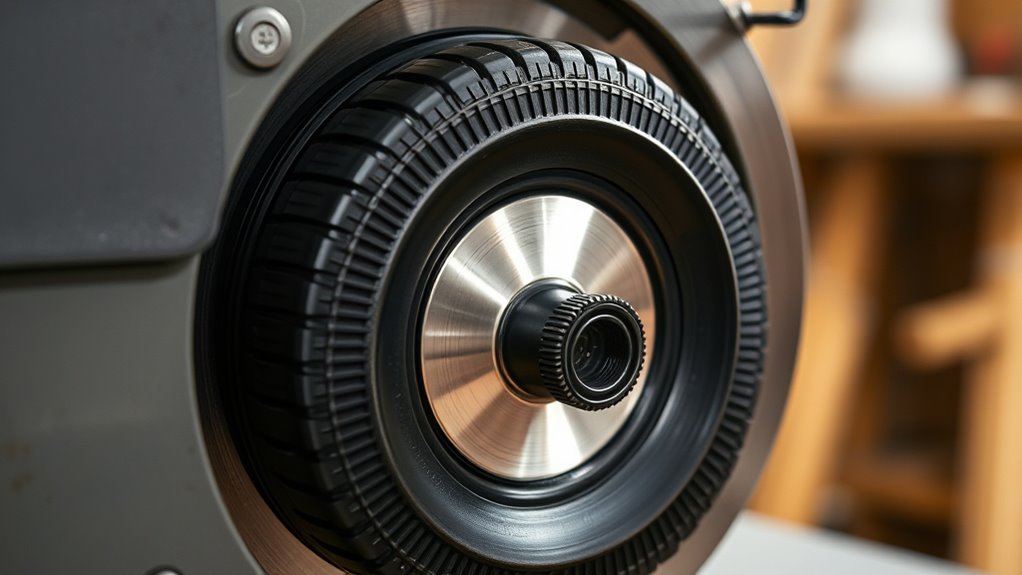
Have you ever wondered how to make precise cuts through thick wood or curves with ease? It all starts with understanding the basics of your bandsaw, especially wheel alignment, tracking, and tension. But before diving into those, you need to focus on blade selection and safety precautions. Choosing the right blade is essential because it directly impacts your cut quality and safety. For example, if you’re cutting thick hardwood, a wider blade with more teeth will give you cleaner, more controlled cuts. On the other hand, for detailed curves or thinner materials, a narrower blade with finer teeth is better. Always check the blade’s specifications to confirm compatibility with your saw and the task at hand. When selecting blades, consider the material, thickness, and the type of cut you want to achieve. Remember, using an inappropriate blade can cause binding or kickback, so take your time to pick the right one.
Safety precautions are equally important. Always wear eye protection and gloves when handling blades or performing maintenance. Keep your fingers away from the blade path, and never reach under or over the saw while it’s running. Make sure the saw is unplugged before adjusting the blade or performing maintenance. Properly securing your workpiece and maintaining a steady feed rate prevents accidents and guarantees cleaner cuts. Never force the material through the blade; let the saw do the work. Also, confirm your workspace is clear of debris and distractions to maintain focus. Additionally, understanding how blade tension affects cut quality can help extend the life of your blade and improve safety.
Once you’ve selected the right blade and taken safety precautions, you can start fine-tuning your bandsaw. Wheel alignment is key for smooth operation. If the wheels aren’t properly aligned, the blade can drift or bind, causing poor cuts and potential hazards. To check alignment, observe the blade as it runs on the wheels; it should sit evenly without wobbling or tracking off-center. If it’s misaligned, adjust the tracking knob until the blade stays centered on the wheels. Tracking is about ensuring the blade runs true along the wheels’ grooves, preventing wandering during cuts. Proper tension is also essential. Too loose, and the blade can slip or wobble; too tight, and you risk damaging the blade or stressing the saw. Adjust tension according to the blade’s width and thickness, following your manufacturer’s instructions.
Frequently Asked Questions
How Often Should Wheel Alignment Be Checked?
You should check your bandsaw’s wheel alignment every 3 to 6 months as part of regular wheel maintenance. If you notice uneven cuts, excessive vibration, or the blade tracking poorly, perform an alignment check sooner. Consistent alignment ensures smoother cuts and prolongs blade life. Don’t wait for problems—regular alignment checks help prevent issues and keep your bandsaw running efficiently, especially if you use it frequently or work on tough materials.
What Signs Indicate Incorrect Blade Tracking?
You’ll notice incorrect blade tracking when your blade wanders or makes uneven cuts. If the blade drifts to one side or the cut isn’t straight, it’s a clear sign of tracking issues. Additionally, if the blade frequently slips off the wheels or creates uneven gouges, it indicates that your tracking needs adjustment. Regularly checking these signs helps maintain precise cuts and prolongs your bandsaw’s life.
How Does Blade Tension Affect Cut Quality?
Think of blade tension as the heartbeat of your cut. When you adjust tension properly, it’s like tuning a finely crafted instrument, producing smooth, precise cuts. Too tight, and you risk blade fatigue, shortening its lifespan; too loose, and your cuts become jagged. Proper tension guarantees consistent contact with the workpiece, improving cut quality and blade longevity. Regular tension adjustments keep your saw singing its best, night after night.
Can Improper Wheel Alignment Cause Blade Damage?
Yes, improper wheel alignment can cause blade damage. When wheels aren’t aligned, you might notice increased wheel vibrations, which put stress on the blade. This can lead to uneven blade wear and potential blade breakage. Misalignment causes the blade to track poorly, increasing friction and heat, ultimately damaging the blade and reducing its lifespan. Always guarantee your wheels are properly aligned to maintain blade health and cut quality.
What’s the Best Method to Calibrate Tension Settings?
To calibrate tension settings accurately, you should first set your blade tension to the manufacturer’s recommended level. Then, perform a tension calibration by plucking the blade like a guitar string and listening for a clear pitch, or use a tension gauge for precise measurement. Adjust the tension until the blade produces the correct sound or gauge reading, ensuring ideal blade tension for safe and efficient cuts.
Conclusion
Mastering wheel alignment, tracking, and tension ensures your bandsaw performs at its best. Did you know that improper tension can reduce blade life by up to 50%? By regularly checking these basics, you’ll prevent costly repairs and improve cut precision. Keep your saw well-maintained, and you’ll enjoy smoother, safer cuts every time. Remember, a little attention to detail now conserves time and money later—so stay vigilant and keep your bandsaw running like new!
